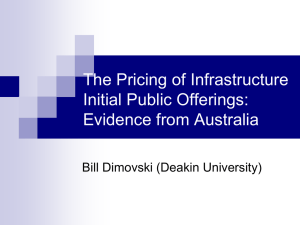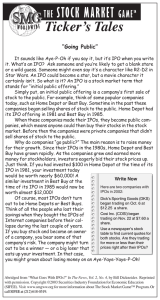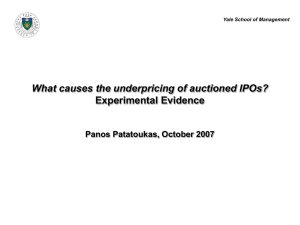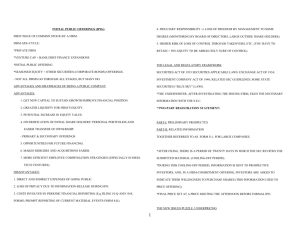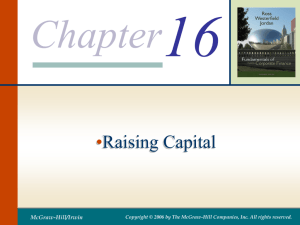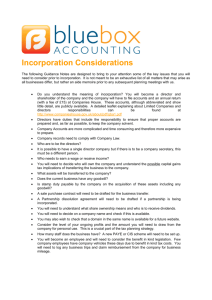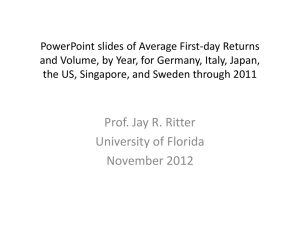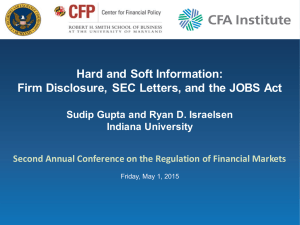Document 13725780
advertisement
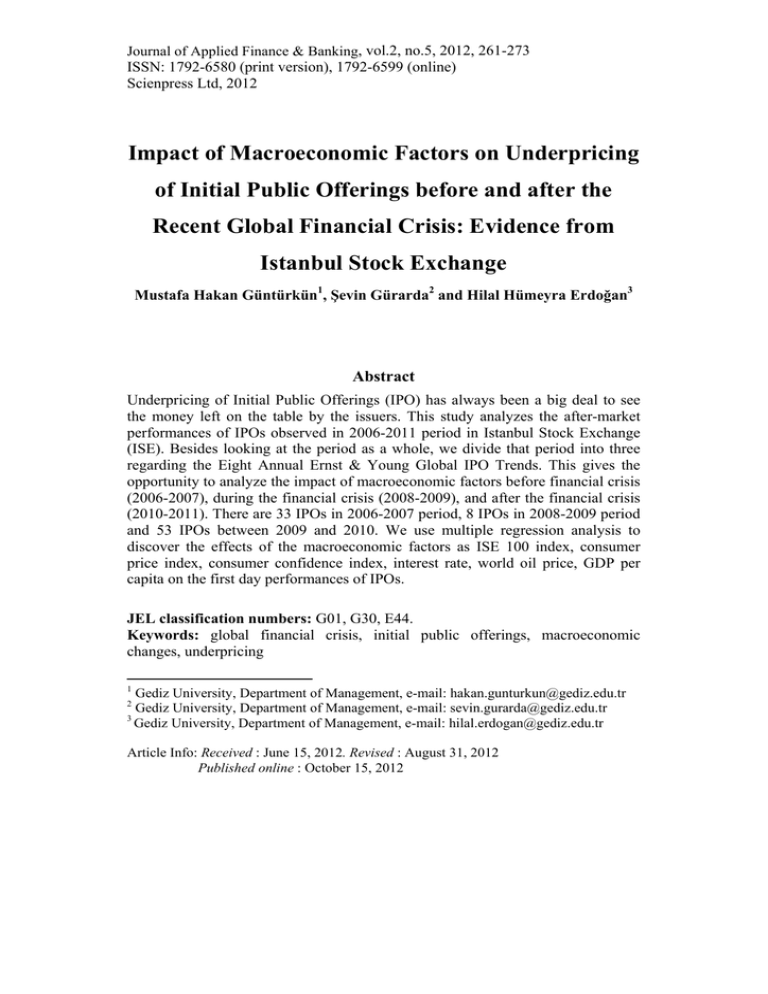
Journal of Applied Finance & Banking, vol.2, no.5, 2012, 261-273 ISSN: 1792-6580 (print version), 1792-6599 (online) Scienpress Ltd, 2012 Impact of Macroeconomic Factors on Underpricing of Initial Public Offerings before and after the Recent Global Financial Crisis: Evidence from Istanbul Stock Exchange Mustafa Hakan Güntürkün1, Şevin Gürarda2 and Hilal Hümeyra Erdoğan3 Abstract Underpricing of Initial Public Offerings (IPO) has always been a big deal to see the money left on the table by the issuers. This study analyzes the after-market performances of IPOs observed in 2006-2011 period in Istanbul Stock Exchange (ISE). Besides looking at the period as a whole, we divide that period into three regarding the Eight Annual Ernst & Young Global IPO Trends. This gives the opportunity to analyze the impact of macroeconomic factors before financial crisis (2006-2007), during the financial crisis (2008-2009), and after the financial crisis (2010-2011). There are 33 IPOs in 2006-2007 period, 8 IPOs in 2008-2009 period and 53 IPOs between 2009 and 2010. We use multiple regression analysis to discover the effects of the macroeconomic factors as ISE 100 index, consumer price index, consumer confidence index, interest rate, world oil price, GDP per capita on the first day performances of IPOs. JEL classification numbers: G01, G30, E44. Keywords: global financial crisis, initial public offerings, macroeconomic changes, underpricing 1 Gediz University, Department of Management, e-mail: hakan.gunturkun@gediz.edu.tr 2 Gediz University, Department of Management, e-mail: sevin.gurarda@gediz.edu.tr 3 Gediz University, Department of Management, e-mail: hilal.erdogan@gediz.edu.tr Article Info: Received : June 15, 2012. Revised : August 31, 2012 Published online : October 15, 2012 262 Impact of Macroeconomic Factors on Underpricing of Initial Public Offerings ... 1 Introduction Initial public offering (IPO) is an outstanding touchstone in the history of a corporation to raise capital. One crucial matter of this phenomenon for both the company and the investors is to determine the pricing of IPO. This is crucial for the company, because the amount of the increase in the price of the stock (underpricing) is the amount of money left on the table for the company. Underpricing is also crucial for the buyers since it refers a lucrative investment. Both the company and the investor sides wish to know the possible underpricing before the offering. Hence it is of primary importance to determine the factors affecting the underpricing of IPOs. There are several studies throughout the world that try to expose the reasons for underpricing. The most of the studies try to understand the implicit factors as size of the firm, age of the firm, etc. (See for example, Durukan, 2002) and the explicit factors as interest rate, GDP, etc. (See for example, Tran and Jeon, 2011 ). Some of those studies are presented in the literature review section. In this paper it was shown that there is a significant underpricing in Turkey, and then we study the macroeconomic determinants of the underpricing in Turkey for the period 2006-2011. Not only the whole period, but also the periods before the world financial crisis, 2006-2007; during the world financial crisis, 2008-2009 and after the world financial crisis 2010-2011 are analyzed. The relationship between the initial return of the IPOs and the macroeconomic factors as ISE 100 index, consumer price index, consumer confidence index, interest rate, world oil price, GDP per capita are evaluated. Multiple regression analysis is conducted. It is found that the factors other than the consumer price index and world oil prices are insufficient to explain the model. Consumer price index is positively and weakly correlated to initial return if the period is considered as a whole. When the periods are assessed separately, it is found that the consumer price index affects the initial return more. World oil price is not a determinant in the pre-crisis period, but it is a determinant in the after crisis period which means that it is one the important factors that determines the investment criteria after the crisis. The remainder of the paper is as follows. Section 2 summarizes some of the related papers in the literature. In section 3, the data is introduced and the methodology of the study is explained. Section 4 gives the results of the regression analysis, and lastly section 5 gives the conclusion. 2 Literature review Levis (1990) analyzed the effect of winner's curse problem and interest rate costs on the emerging first day net returns and compared with the level of underpricing. The sample consists of all 'offers for sale' which started trading on the London Stock Exchange Official List and the Unlisted Securities Market during the period between January 1985 and December 1988. Accordingly, by Mustafa Hakan Güntürkün, Şevin Gürarda and Hilal Hümeyra Erdoğan 263 using CAPM and regression analysis, the paper finds evidence that the winner’s curse and interest rate costs explain underpricing. Chowdhry and Sherman (1996) explained the reason of underpricing in case of information leakage. By comparing US and UK style IPOs, they examined the differences between oversubscription and underpricing. They argue that the interest earned on the subscription funds reduces the cost of underpricing and thus induce issuers to underprice more. From this point of view, they conclude that the underpricing is higher in the periods when interest rates are high. Breinlinger and Glogova (2002) examined the relationship between IPOs and macroeconomic factors such as stock index returns, changes in savings deposits, gross domestic product (GDP) growth and interest rates, using annual observations of IPO volumes for six continental European countries for the period 1980-1997. Panel data analysis shows that neither interest rates nor GDP growth exhibits any significant influence. Johnston & Madura (2003) investigated the effect of interest rate on initial return of financial institutions engaged in IPOs, using data from 431 IPOs during January 1986 - December 1998. The ordinary least squares (OLS) regression results suggest the degree of underpricing of financial institution IPOs, especially investment banks, are influenced by environmental conditions that affect the degree of uncertainty. The analysis also shows that the degree of underpricing of financial institution IPOs is higher during the periods of high interest rates. Hopp & Dreher (2007) analyzed the determinants of Initial Public Offering (IPO) underpricing, using data from 29 countries over the period 1988-2005. They examined the importance of institutional and legal factors in explaining crosscountry variations including GDP growth by using panel data and regression analysis. Accordingly, they didn’t find any significant relationship between GDP and underpricing. Higher values traded in the stock market are more significant than GDP in explaining underpricing. Zozan (2007) investigated the initial and after-market returns for the Turkish IPOs during 1996-2006. In investigation of the factors influencing the initial performance, control variables such as the percentage change in ISE-100 index during last 15 days before the first trading day are employed. The regression results suggest that the underpricing is one of the main characteristics of the Turkish IPO market. The percentage change in ISE-100 index during last 15 days before the first trading day has a significant positive coefficient, suggesting that the rising market between the offer price time and the first trading day is one of the determinants of underpricing. Fung & Che (2009) use data from a sample of 386 IPOs at Hong Kong listed between 2000 and 2007, the regression results show that interest earnings and underpricing are highly correlated. Erdogan (2010) analyzed 126 IPOs traded on ISE from 1995 to 2000. To analyze the long run stock price behavior of initial public offerings (IPOs), cumulative abnormal returns (CARs), wealth relatives, buy-and-hold abnormal returns (BHARs), calendar-time abnormal returns (CTARs) were used. The results 264 Impact of Macroeconomic Factors on Underpricing of Initial Public Offerings ... analyzed by using Istanbul Stock Exchange 100 Index after two years, after three years and after five years, show that the performance of IPOs depends on the choice of the performance measurement methodology. Underperformance was found only for wealth relatives and BHARs method. Tran & Jeon (2011) investigated the relationship between IPO activities and the macroeconomic factors during the period from 1970 to 2005 in US. They applied unit-root test, co-integration test, the Vector Error Correction (VEC) model, Ordinary Least Squares (OLS) regression, the multivariate, Vector Autoregressive model (VAR), Impulse Response Function (IRF) analysis as timeseries econometric techniques. Results indicate that there are long-run equilibrium relationships between underpricing of IPOs and selected macroeconomic variables such as IP index, S&P 500 index, CPI. 3 Methodology and data The sample consists of 75 IPOs launched in Turkey from 2006 to 2011. The data is obtained from the ISE. The total number of IPOs realized in the sample period is 93. Four firms are omitted from the sample due to the incomplete information, eleven firms are excluded for being exchange traded funds and three firms are not taken due to the merged transactions. Table 1 reports the distribution of the sample IPOs by year. The number of IPOs fluctuates during the sample period. The impact of global financial crisis on the number of IPOs by capturing 2008 and 2009 is clear. Table 1 also summarizes the frequency of IPOs by year. The highest number of IPOs is observed in 2011 with 27 IPOs, followed by 26 IPOs in 2010. Table 1: Distribution of the sample IPOs by year (2006-2011) Year Total Number of IPOs Merged Acquired 2006 2007 2008 2009 2010 2011 Total 21 11 3 5 26 27 93 2 1 3 Others Number of IPOs included 7 3 1 1 3 15 12 8 2 3 23 27 75 % of IPOs included 57% 73% 67% 60% 88% 100% 81% Mustafa Hakan Güntürkün, Şevin Gürarda and Hilal Hümeyra Erdoğan 265 The macroeconomic factors explaining Initial Return are determined by examining the similar papers in the literature. These are ISE 100 index, consumer price index, consumer confidence index, interest rate, world oil price, GDP per capita. ISE 100 Index is taken from Istanbul Stock Exchange, consumer price index, consumer confidence index, GDP per capita are taken from Turkish Statistical Institute, and the interpolations of the population are made for the months, interest rates are Central Bank maximum deposit rates , World Oil Price is the Europe Brent spot price. The total return for the stock i in the period t is calculated as in Equation (1) where Pi,t is the price of the stock i at time t and Pi,0 is the offer price. Pi ,t Ri ,t 1 (1) Pi ,0 The Market Index is calculated as follows: P Rm ,t m,t 1 Pm,0 where Pm,t is the market index value at time t and Pm,0 is the market index value at the offer date. Two measures of performance are calculated for each initial public offering: Initial Underpricing: While initial raw return for each stock is defined as relative price change from the offer price to the closing price at the end of first trading day, the initial adjusted return is defined to be the initial raw return less the market return on initial day. Long-Run Returns: Daily market adjusted abnormal returns for stock i in event day t is defined as: ARi ,t Ri ,t Rm ,t The standard event methodology is applied to calculate the average abnormal returns and the cumulative abnormal returns. 4 Results Table 2 presents the initial and immediate after-market adjusted daily average abnormal returns (AARs) for all firms from the first trading day to the end of one month. The mean underpricing for all firms is 7,7%. Although we use different data and sample period, our results support the findings of Kiymaz (2000), Durukan (2002), Kucukkocaoglu (2005) and Zozan (2007). Their results also indicate statistically significant underpricing for the periods 1990-1996, 266 Impact of Macroeconomic Factors on Underpricing of Initial Public Offerings ... 1990-1997, 1993-2005 and 1996-2006, respectively. Hence, our results together with the results of the previous studies suggest that the underpricing is one of the main features of the Turkish IPO market. Table 2: Initial , Average & Cumulative Abnormal Returns for all companies All firms (n=75) AAR CAR Initial Return 2nd day 3rd day 4th day 1st week 2nd week 3rd week 1st month 0,077** 0,092** 0,104** 0,110* 0,231* 0,234* 0,234* 0,347* 0,077* 0,014** 0,011 0,005 0,121*** 0,003 -0,000 0,113* Note: *,**,*** denote statistical significance at 1%, 5%, and 10%, respectively The after-market AARs show that sample of all firms enjoy positive excess returns only in next two days after the first trading day. Then excess returns vanish and it becomes statistically insignificant. Table 3 reports initial returns with year by year breakdown. As seen in Table 3, initial returns fluctuate significantly during the sample period. The sample period witnessed global financial crisis starting in September, 2008. This event has an obvious impact on the initial returns. The number of the firms that go public decreased in 2008 and 2009. In 2008 (May) there are only two firms that go public. Since their IPOs were in May, the effect of financial crisis has not been observed in firms in 2008. However, in 2009 negative but insignificant initial return is observed. At the end of the second week of IPOs in 2008, significant negative adjusted abnormal return is observed. The highest significant initial return is seen in 2011 and it is followed by 2007. Table 4 reports the cumulative abnormal returns (CARs) by years ranging 2day to 1-month. Except financial crisis period that covers 2008 and 2009, the results show that the statistically significant underpricing continues to be present in the first 4 weeks. In 2008, CARs are positive but statistically insignificant. In 2009, they are negative and statistically insignificant. Mustafa Hakan Güntürkün, Şevin Gürarda and Hilal Hümeyra Erdoğan 267 Table 3: Initial and Average Abnormal Returns (1st day-1st Month) (AARs) No. of Initial Year firms Return nd 2 day rd 3 day th 4 day 1st week 1st 2 week 3 week month nd rd 0,060* 0,024*** 0,010*** 0,001*** 0,081* -0,022* 0,005* 0,039* 8 0,078* -0,004 0,023 -6,693 0,122* -0,038 -0,025* 0,044* 2008 2 0,0980 0,1090 0,1120 0,1090 0,5330 0,031*** -0,1760 0,0990 2009 3 -0,169 0,0007 -0,096 0,004 -0,279 -0,008 0,029** -0,343 2010 23 0,018* 0,016 0,028* 0,002*** 0,085* 0,019* 0,006* 0,114* 2011 27 0,160** 0,009*** 0,009*** 0,010*** 0,182** 0,0150 0,0140 0,218** 2006 12 2007 Note: *,**,*** denote statistical significance at 1%, 5%, and 10%, respectively Table 4: Cumulative Abnormal Returns (1st day-1st Month) (CARs) No. of Initial Year firms Return 2nd day 3rd day 4th day 1st week 2nd week 2006 12 0,060* 0,084* 0,073* 0,072* 0,154* 0,131* 0,137* 0,177* 2007 8 0,078* 0,074* 0,097* 0,097* 0,219* 0,180* 0,155* 0,200* 2008 2 0,0980 0,2080 0,3210 0,4300 0,9630 0,9310 0,7550 0,8550 2009 3 -0,169 -0,168 -0,264 -0,260 -0,539 -0,548 -0,577 -0,920 2010 23 0,018* 0,035* 0,064* 0,061* 0,146* 0,165* 0,171* 0,286* 2011 27 0,160** 0,170** 0,179** 0,190** 0,372** 0,388** 0,403** 0,622** 1st 3 week month rd Note: *,**,*** denote statistical significance at 1%, 5%, and 10%, respectively 268 Impact of Macroeconomic Factors on Underpricing of Initial Public Offerings ... Overall, our results indicate that the Turkish IPOs experience a statistically significant under pricing both on the initial day and in the immediate after-market periods. But in the long-run we observe statistically significant and mostly negative abnormal returns just for 2006. For the other years, stable statistically significant returns are not seen. The global financial crisis has an obvious impact on the initial returns. The Model for 2006-2011 Period We model the whole period (2006-2011) by using multiple regression analysis. We use forward selection method and look at the Q-Q plot of the residuals. According to the normal Q-Q plot of the standardized residuals, the distribution of the standardized residuals is different from normal distribution. Also if we look at the normality tests, in both Kolmogorov-Smirnov and ShapiroWilk test normality is rejected. Therefore, in order to correct the non-normality problem the response should be transformed. To determine the suitable transformation we look at the Box-Cox plot. Since some of the response values are smaller than zero we add one to all response values to apply box cox transformation. According to this plot, since the rounded value of lambda is 0,5, taking the square of the initial return gives an appropriate transformation. After applying square root transformation to the response variable, we again employ forward selection technique. After constructing the model, we check the regression assumptions. We sketch the scatter plot to see the linearity of the relationship between the response y and the regressors. This plot indicates outliers in the data. We utilize the hat matrix and the studentized deleted residuals to detect the outlying the X and Y observations. We also look at the summary of influence statistics to see their effects. According to the results of Cook’s distance test, two cases are influential in the fitting of the regression function. Then we fit the regression model again without these cases. Table 5: Regression Results For 2006-2011 Period Mo del 1 R ,305(a) R Square ,093 Adjuste dR Square ,080 Std. Error of the Estimate ,07134 R Square Change ,093 Change Statistics F df df Chang 1 2 e 7,271 1 a Predictors: (Constant), VAR00004 (Consumer Confidence Index) b Dependent Variable: VAR00001 (Initial Return) 71 Change Durbin Watson ,009 1,933 Sig. F Mustafa Hakan Güntürkün, Şevin Gürarda and Hilal Hümeyra Erdoğan 269 Table 6: Regression Coefficients For 2006-2011 Period Model 1(Constant) VAR00004 Unstandardized Coefficients B Std. Error ,640 ,004 ,144 ,002 Standardized Coefficients Beta ,305 t Sig. 4,440 2,696 ,000 ,009 a Predictors: (Constant), VAR00004 b Dependent Variable: VAR00001 All the regression assumptions are satisfied by this model. The test for the normality assumption is as follows: Table 7: Normality Test For 2006-2011 Period Standardized Residual Kolmogorov-Smirnov Statistic df Sig. ,077 73 ,200 Shapiro-Wilk Statistic df Sig. ,918 73 ,000 While we reject the normality assumption in Shapiro-Wilk test, we accept it in Kolmogorov-Smirnov test for α=0,05. Then, we can assume that errors are normally distributed. In conclusion, all the regression assumptions are satisfied so our model is valid. Then, the regression equation is C1 = 0,64 + 0,004*C4 where C1:Initial Return(transformed), C4:Consumer Confidence Index (CCI) R-Sq = 9,3% R-Sq(adj) = 8% This analysis shows only that CCI positively affects the Initial Return. However CCI is insufficient to explain Initial Return and it explains only 9,3% of the variance in Initial Return. The other variables can’t explain the variation of the Initial Return contrary to expectations. The Model for 2006-2007 Period In this step we model the pre-crisis period (2006-2007) by using the multiple regression analysis. 270 Impact of Macroeconomic Factors on Underpricing of Initial Public Offerings ... Table 8: Regression Results For 2006-2007 Period Mo del 1 Squar e Adjuste dR Square ,397 ,363 R R ,630(a) Std. Error of the Estimat e ,09323 Change Statistics R Squar e Chang e ,397 Change df 1 df 2 Sig. F Chang e DurbinWatson 11,843 1 18 ,003 2,415 F Table 9: Regression Coefficients For 2006-2007 Period Model 1 (Constant) VAR00042 Unstandardized Std. Error -1,605 ,487 ,018 ,005 Standardized Beta t B 3,441 ,630 Sig. Std. ,004 ,003 We look at the normality tests, in both Kolmogorov-Smirnov and ShapiroWilk test (see below) normality is accepted. All the other regression assumptions are also satisfied, so our model is valid. Table 10: Normality Test For 2006-2007 Period Kolmogorov-Smirnov Standardized Residual Statistic ,105 df 20 Shapiro-Wilk Sig. Statistic df Sig. ,200 ,984 20 ,971 The regression equation is Initial return= -1,605 + 0,018*consumer confidence index R-Sq = 39,7% R-Sq(adj) = 36,3% In also pre-crisis period only CCI positively affects the Initial Return. However the explanation power of CCI in this period is more than the whole period, it explains 39,7% of the variance in Initial Return. The Model for 2008-2009 Period In this period we have just 3 IPOs in 2008 and 5 IPOs in 2009, hence we don’t have sufficient data, we do not analyze this period. Mustafa Hakan Güntürkün, Şevin Gürarda and Hilal Hümeyra Erdoğan 271 The Model for 2010-2011 Period In this step we model the after-crisis period (2010-2011) by using the multiple regression analysis. We exclude one case which is an outlier that is tested above. Table 11: Regression Results For 2010-2011 Period Mo del R R Squar e 1 2 ,408(a) ,490(b) ,166 ,240 Adjuste dR Square ,148 ,207 Std. Error of the Estimat e ,13766 ,13280 Change Statistics R Square Chang e ,166 ,074 F Chang e df 1 df 2 Sig. F Chang e 9,36 4,504 1 1 47 46 ,004 ,039 Durbin Watso n 2,067 a Predictors: (Constant), VAR00004(consumer confidence index) b Predictors: (Constant), VAR00004, VAR00006(word oil price) Table 12: Regression Coefficients For 2010-2011 Period Model 1 2 Unstandardized ffi i Std. (Constant) VAR00034 (Constant) VAR00034 -1,410 ,479 ,016 -2,442 ,032 -,004 ,005 ,671 ,009 ,002 Standardized ffi i Beta ,408 ,802 -,479 t B -2,944 Sig. Std. ,005 3,059 -3,640 3,549 -2,122 ,004 ,001 ,001 ,039 We look at the normality tests; in both Kolmogorov-Smirnov and ShapiroWilk test (see below) normality is accepted. All the other regression assumptions are also satisfied so our model is valid. Tests of Normality Table 13: Normality Test For 2010-2011 Period Kolmogorov-Smirnov Standardized Residual Statistic ,081 df 49 Shapiro-Wilk Sig. Statistic df Sig. ,200 ,968 49 ,208 272 Impact of Macroeconomic Factors on Underpricing of Initial Public Offerings ... The regression equation is Initial return= -2,442 + 0,032*consumer confidence index – 0,004*word oil price R-Sq = 24% R-Sq(adj) = 20,7% After-crisis period is different from the other periods in the manner that world oil price affects the Initial Return negatively besides the CCI. However both CCI and WOP are still inefficient to explain Initial Return, they explain only 24% of the variance in Initial Return. 5 Conclusion This study shows that there exists underpricing of initial public offerings between 2006 and 2011 in Turkey. Then we try to understand the effects of ISE 100 index, consumer price index, consumer confidence index, interest rate, world oil price, GDP per capita on the initial return of IPOs (underpricing). It is found that ISE 100 index, consumer price index, interest rate, GDP per capita does not affect underpricing between 2006 and 2011. The pre-crisis and after-crisis periods are also analyzed separately. ISE 100 index, consumer price index, interest rate, GDP per capita don’t have any effect on initial return in these periods, too. Due to the insufficient number of data, the financial crisis period of 2008-2009 is not evaluated. This means that the corporations didn’t choose to go public in financial crisis period. The results show that ISE 100 index, consumer price index, interest rate, GDP per capita does not affect the desire of people to invest on initial public offerings between 2006 and 2011. Also it is also confirmed that the financial crisis does not have any effect on this phenomenon. Consumer confidence index (CCI) is weakly correlated to initial return in the whole period. Also this is the only determinant of underpricing in the whole period. If we separate the period to smaller periods (2006-2007 and 2010-2011), we see that the effect of CCI increases. The meaning of this is if people expect to be better financially and if they think the market to boom, they tend to invest more in initial public offerings. World oil price (WOP) is not a determinant of underpricing if the whole period is considered. Also it is not a determinant if only the pre-crisis period is taken into consideration. However after the crisis period it affects the underpricing. It is known that the WOP is one of the main economic indicators affecting all countries. This means that, after the world financial crisis, people make their investments also considering the general economic situation of the whole world besides the other factors. Mustafa Hakan Güntürkün, Şevin Gürarda and Hilal Hümeyra Erdoğan 273 References [1] Breinlinger and Glogova, Determinants of Initial Public Offerings: A European Time-Series Cross-Section Analysis, Oesterreichische Nationalbank Financial Stability Report, 3, (2002), 87-106. [2] Chowdhry, Bhagwan and Sherman, International Differences in Oversubscription and Underpricing of Initial Public Offerings, Journal of Corporate Finance, 2(4), (1996), 359-381. [3] M.B. Durukan, The Relationship Between IPO Returns and Factors Influencing IPO Performance: Case of Istanbul Stock Exchange, Managerial Finance, 28, (2002), 18-28. [4] A.İ. Erdogan, The Long-Run Performance of Initial Public Offerings: The Case of Turkey, European Journal of Economics, Finance and Administrative Sciences, 26, (November, 2010), 57-64. [5] Fung and Che, Initial Day Return and Underpricing Cost in Advance Payment Initial Public Offerings, HKIMR Working Paper, 35, (2009). [6] Hopp and Dreher, Do Differences In Institutional And Legal Environments Explain Cross-Country Variations In IPO Underpricing?, CESifo Working Paper Series, 2082, CESifo Group Munich, (2007). [7] Johnston and Madura, Underpricing of Financial Institution IPOs, Financial Decisions, 15(1), (2003). [8] M. Levis, The Winner’s Curse Problem, Interest Costs and the Underpricing of Initial Public Offering, Economic Journal, 100(399), (1990), 76-89 [9] H. Kiymaz, The Initial and Aftermarket Performance of IPOs in An Emerging Market: Evidence From Istanbul Stock Exchange, Journal of Multinational Financial Management, 10(2), (2000), 213-227. [10] G. Kucukkocaoglu, Underpricing in Turkey: A Comparison of The IPO Methods, International Research Journal of Finance and Economics, 13, (2008), 162-182. [11] Tran and Jeon, The dynamic impact of macroeconomic Factors on initial public Offerings: Evidence from time-series analysis, Applied Economics, 43(23), (2011), 3187-3201. [12] Ş. Zozan, Underpricing of Initial Public Offerings Listed on The Istanbul Stock Exchange, Unpublished Master Thesis, Dokuz Eylul University, Institute of Social Sciences, İzmir, 2007.
